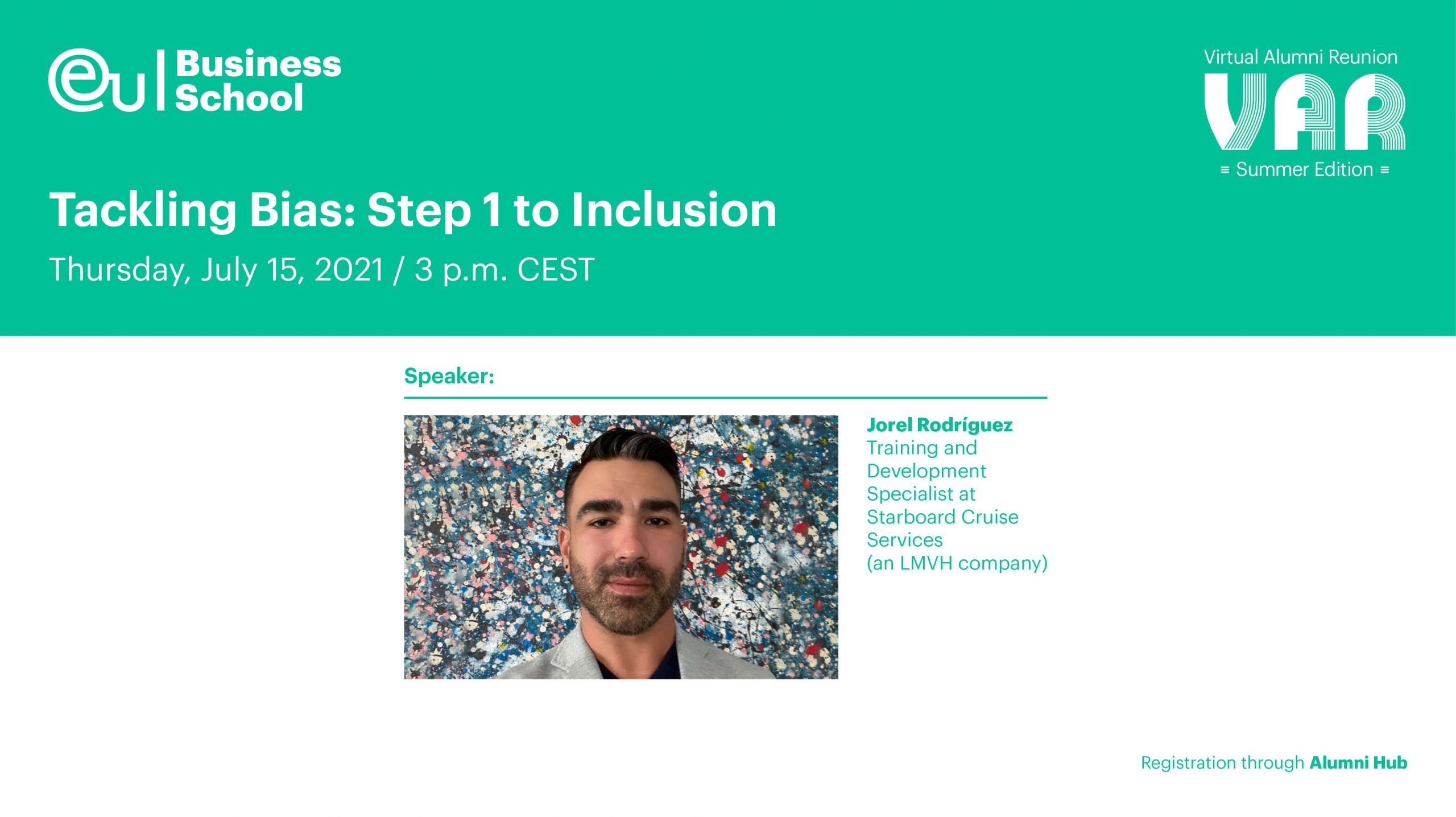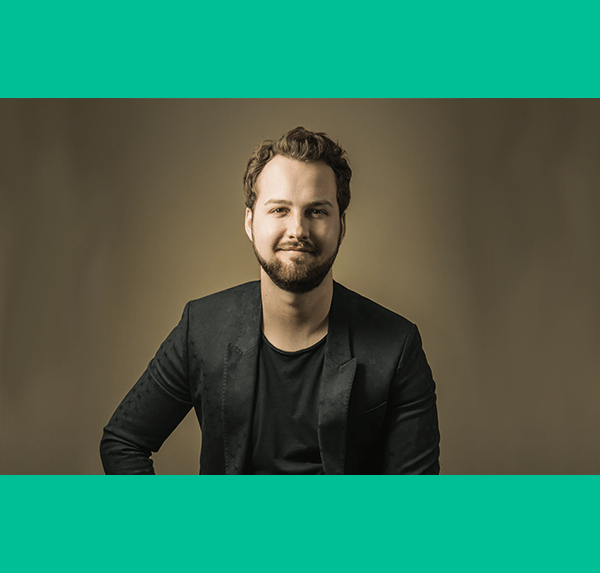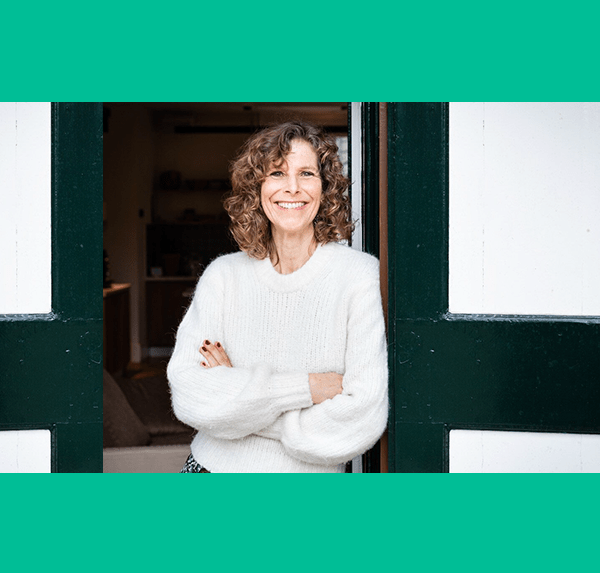Virtual alumni Reunion – Tackling Bias: Step 1 to Inclusion
Jorel Rodriguez, Co-Head of D&I at Starboard Cruise Services, spoke to former students of EU Business School as part of our Virtual Alumni Reunion series this summer. The event was tailored towards an exploration of how diversity and inclusion are changing business.

He followed Victoria Williams, the Global Corporate Implementation Manager at American Express, who spoke passionately about the importance of creating safe and inclusive workplaces. Jorel then delivered a masterclass on tackling bias, which he believes is the first step towards achieving Victoria’s vision of a diverse, inclusive, and equitable company culture.
He began by saying that, whether we are aware of it or not, we all have biases. Most often, you’ll hear these called “unconscious” or “implicit” biases, and a lot of people feel uncomfortable facing up to them because being biased is perceived as negative. However, to combat these biases, we do have to learn what they are and acknowledge them. This will allow us, as leaders, to implement changes in our behavior, which will make our organizations more collaborative, more inclusive, and more competitive.
In this article, we have summarized Jorel’s findings on how unconscious bias can affect us and what we can do to tackle it in the workplace. But first, to make sure we’re all on the same page about what he means, let’s find out: What is unconscious bias, and why do we have it?
What is unconscious bias?
Simply put, unconscious bias is just a preference for or against something. Looking at it in a bit more detail, Jorel added that unconscious bias also:
- Covers attitudes or stereotypes that affect our understanding, actions, and decisions in an unconscious manner.
- Includes both favorable and unfavorable assessments.
- Is activated involuntarily without awareness or intentional control.
- Does not necessarily align with our declared beliefs.
Why do we have unconscious bias?
What we now call unconscious biases are actually lightning-fast reactions triggered in our brains by our very human need to survive. Back when we were hunter-gatherers, we might have encountered an animal that we needed to assess quickly. Four legs, fur, sharp teeth, not friendly… This is a lion, a predator, and we need to run very fast in the other direction. Without that ability to process thousands of pieces of information instantly, we would not have made it this far as a species.
Bias also relates to how we interpret the world around us, and it happens at the same speed, so Jorel used this image of the caveman and the lion to illustrate that, sometimes, the shortcuts our brain takes can be very functional. The problem is, when it comes to making decisions about or involving people, this can sometimes steer us in the wrong direction.
The biases we were brought up with, whether they come from our culture, our religion, or how we were educated, have shaped our understanding of the world as we have grown, and—as Jorel kept affirming throughout the session—that’s okay. But we do need to become aware of how that understanding manifests itself in our everyday and workplace interactions with others.
How does unconscious bias affect our behavior?
Unconscious bias affects our behavior in a number of significant ways. In fact, it impacts all of the following:
- Our perception. Unconscious bias affects how we see people and how we perceive reality.
- Our attitude. It determines how we respond to other people.
- Our behavior. How receptive or friendly we are to others depends on our unconscious biases.
- Our attention. Ask yourself, who do I pay attention to, and what aspects of them do I pay attention to? What do I ignore? The answers to these questions will give you a better understanding of your unconscious biases.
- Our listening skills. Due to unconscious bias, we may listen more actively to specific people or groups than others.
- Our micro-affirmations. How much we sympathize with certain people in specific situations comes down to what our biases are.
Furthermore, there are several different types of biases that come under this umbrella of “implicit bias,” including:
- Affinity bias – the tendency to ignore negative traits of people we like and focus on the faults of people we don’t. This comes into play in the workplace during the hiring process, mentorship schemes, and how well teams work together.
- Confirmation bias – the way we make decisions is largely designed to confirm the beliefs we already have. What we hear about people impacts how we perceive and act towards them, because we are searching for validation to confirm what we believe about them. Beware of confirmation bias when a new person joins your team or organization!
- Attention bias – selectively seeing some things but not others, depending on your point of focus, which can lead to you missing out on great hires or amazing new ideas during project development or the product design stage of your operations.
- Attributing bias – attributing certain qualities to a person or thing based on initial perceived value. For example, hiring managers are known to make assumptions about candidates based on names, neighborhoods, accents, etc., which can exclude whole groups of people from opportunities at your workplace.
How do we combat unconscious bias?
- Be self-aware. We all have biases, and now that we’ve acknowledged that, we have to increase our awareness of our specific biases, how they manifest themselves, and how they impact our business decisions. Some things to ask yourself are:
- What diversity dimensions (race, ethnicity, gender, sexual orientation, education, industry) might have created biases for you?
- How might these biases show up in relationships, talent, and business decisions?
- Remember that it is unconscious. As you gain this awareness, you must be gentle with yourself. However, at the same time, you must also accept the discomfort of unlearning and relearning different things.
- Diversify your decision-making process. For example, work with people who hold different views to limit the impact of any one person’s unconscious bias.
- Challenge yourself to actively manage bias and create a culture of conscious inclusion at your company.
Once you have become aware, the next steps involve learning how to be more inclusive. Understanding, including, and valuing our differences will make a huge difference to your business.
To learn more about how you can become an inclusive leader, look out for our final blog post in this series, The Role of Developing Inclusive Leaders in Organizations—coming soon from EU Business School!










